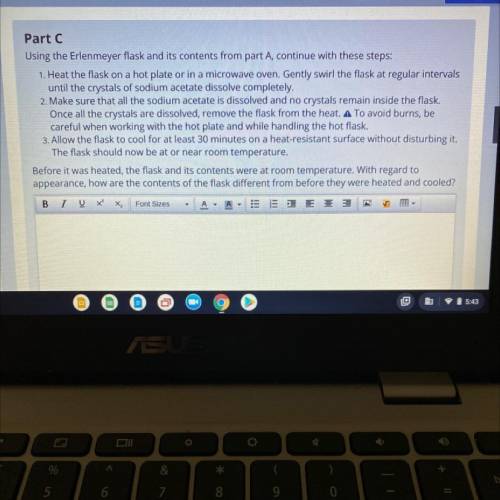
Chemistry, 20.05.2021 02:10, greenhappypiggies
Part C
Using the Erlenmeyer flask and its contents from part A, continue with these steps:
1. Heat the flask on a hot plate or in a microwave oven. Gently swirl the flask at regular intervals
until the crystals of sodium acetate dissolve completely.
2. Make sure that all the sodium acetate is dissolved and no crystals remain inside the flask.
Once all the crystals are dissolved, remove the flask from the heat. A To avoid burns, be
careful when working with the hot plate and while handling the hot flask.
3. Allow the flask to cool for at least 30 minutes on a heat-resistant surface without disturbing it.
The flask should now be at or near room temperature.
Before it was heated, the flask and its contents were at room temperature. With regard to
appearance, how are the contents of the flask different from before they were heated and cooled?


Answers: 2
Other questions on the subject: Chemistry

Chemistry, 22.06.2019 02:30, brittanysanders
When you perform this reaction, what could remain at the end of the reaction? check all that apply. excess reactant aqueous copper chloride excess reactant aluminum oxygen product solid copper carbon dioxide product aqueous aluminum chloride water
Answers: 2

Chemistry, 22.06.2019 08:30, omoaye
Identify one disadvantage to each of the following models of electron configuration: -dot structures -arrow and line diagrams -written electron configurations type in your answer below. (answer) -dot structures do not show the distribution of electrons in orbitals and take up a lot of space. -arrow and line diagrams take up a lot of space and make it difficult to count electrons. -written configurations make it easy to lose count of electrons and do not show the distribution of electrons in orbitals.
Answers: 3

Chemistry, 22.06.2019 09:00, tashaunalewis4786
This chart lists four kinds of polymers and their sources. what can be known about all four polymers, despite their differences? they come from living things. they share ionic carbon bonds. they are at least 100 monomers long. they are made of repeating subunits.
Answers: 1

Chemistry, 22.06.2019 09:00, kcarstensen59070
What type of energy do chemical bonds have? what type of energy is it converted to during chemical reactions? question 15 options: chemical bonds have kinetic energy, which is converted to potential energy during chemical reactions. chemical bonds have electric energy, which is converted to potential energy during chemical reactions. chemical bonds have heat energy, which is converted to kinetic energy during chemical reactions. chemical bonds have potential energy, which is converted to heat energy during chemical reactions.
Answers: 1
Do you know the correct answer?
Part C
Using the Erlenmeyer flask and its contents from part A, continue with these steps:
1....
1....
Questions in other subjects:

Advanced Placement (AP), 09.11.2020 22:00





Mathematics, 09.11.2020 22:00


Business, 09.11.2020 22:00

Mathematics, 09.11.2020 22:00

History, 09.11.2020 22:00






